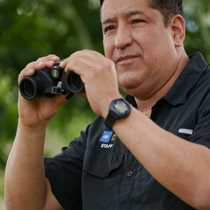Atum Poza & Pacaya River
Today we experienced firsthand the extraordinary biodiversity of the Pacaya–Samiria National Reserve. The Pacaya–Samiria National Reserve is one of the largest protected areas in Peru with an area of more than 5 million acres (7,700 ml², 20,800 km²). In comparison this huge reserve is equivalent in size to the state of New Jersey. The reserve is also the largest protected seasonal flooded forest in South America. The reserve is made up of three hydrographical basins: the Samiria River drainage, the Pacaya River drainage, and the Yanayacu-Pucate drainage. Today we are visiting Pacaya drainage basin.
Atum Poza Lake was our point of entry to the basin. In this area we observed many bird species like, flycatchers, egrets, hawks, and the magnificent Jabiru that is a large colorful stork. In addition to the many animal species, that include a couple of Squirrel monkey and the rarely seen Brown Capuchin monkey troops, we had the thrill to have our breakfast outdoors on board the skiffs! This experience, as you can imagine, is great! We had our first meal of the day served in the rain forest in the most fashionable way, with white gloves and fabric napkins included. The beautiful green coverage of the surroundings and a concert of forest sounds made an idyllic setting for this memorable breakfast. In the way back to the ship we stopped for a short time in Atun Poza Lake Community to admire the local women´s handcrafts.
Before lunch we had some amusing and informative activities. We had a medicinal plants exhibition, a talk about the local indigenous groups of the reserve, including learning how to use the blowgun and a cooking lesson of a regional dish.
In the afternoon accompanied by a soft drizzle rain we started a little earlier than usual, at 15:00, with the intention to go as far as we could inside the Pacaya River. After crossing many grassy passages and shortcuts we arrived to a very large lagoon known as Yanayacu. The afternoon was very hot therefore the water felt wonderful. We had the surreal company of several Pink River Dolphins (Inia geoffrensis) that were seen at a short distance swimming in the same place with us. After swimming we continued exploring and our efforts were rewarded by the observation of a couple of troops of the largest monkey species of the reserve, the Red Howler Monkey (Alouatta seniculus).
Late in the evening at around 18:15, with the sunset already in the horizon, we came back on board. We were far and beyond the Pacaya River. We had a wonderful mix, the feeling of well being and the certainty that we were at least for some hours part of the intricate and magical complexity of the Amazon region.




